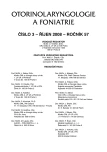A Contribution to Application of Videostroboscopy in Otorhinolaryngology
Authors:
A. Slavíček; M. Zábrodský; A. Jašková; A. Bahannan
Authors‘ workplace:
Katedra otorinolaryngologie IPVZ, Praha
přednosta prof. MUDr. J. Betka, DrSc.
; Klinika otorinolaryngologie a chirurgie hlavy a krku 1. LF UK a FN Motol, Praha
Published in:
Otorinolaryngol Foniatr, 57, 2008, No. 3, pp. 138-142.
Category:
Original Article
Overview
The objective of this prospective study is to use videostroboscopic recordings for comparing probands with benign and malignant lesions of vocal cords with a control group of patients. According to null hypothesis there is no difference between videostroboscopic recordings of the groups A, B, C, D, E and F. A total of 80 patients were included in the study, 31 men and 49 women. The probands were accordingly divided into 5 groups: Group A included 7 patients with squamous cell carcinoma of vocal cord at the T1 or T2 stage, group B included 10 patients with dysplasia of I-III degree, group C encompassed 11 patients with vocal cord oedema, group D included 15 patients with a cyst on vocal fold and group E contained 26 patients with a benign polyp on one of the folds. The control group F embraced 11 patients with negative laryngological anamnesis and a normal voice.
In order to evaluated videostroboscopic recordings and their quantification for statistical evaluation, two parameters were selected: maximum width of the opening (rima glottis) in the region of comissura posterior during phonation and amplitude of mucous wave during phonation. The width was evaluated as none, 1 mm, 2-3 mm, or more than 3 mm. The amplitude of mucous wave was evaluated as increased, normal, decreased or completely absent.
It is possible to say that the mean maximum width of the opening in the area of comissura posterior was enlarged especially in group B (dysplasia) and further in the order of group A (carcinomas), group C (oedemas), groups E (polyps) and group D (cysts). In the control group F the maximum width of opening in the comissura posterior region reached the lowest mean value.
The mucous wave was the least affected one in control group F without any disease of larynx and in group D of patients with vocal folds affected by cysts, where it was normal in 100%. The mucous wave was increasingly affected in the order of group E with polyps, in group A with oedemas, in group B with dysplasia and in group A of patients with carcinoma of vocal folds.
Key words:
videostroboscopy, carcinoma, larynx.
Sources
1. Behrman, A., Abramson, A. L., Myssiorek, D.: A comparison of radiation-induced and presbylaryngeal dysphonia. Otolaryngol. Head Neck Surg., 3, 2001, s. 193-200.
2. Beranová, A., Betka, J.: Nové možnosti v léčbě dysfonie. Otolaryngolog. a Foniat./Prague/, 2, 2003, s. 75-79.
3. Casiano, R. R., Zaveri, V., Lundy D. S.: Efficacy of videostroboscopy in the diagnosis of voice disorders. Otolaryngol. Head Neck Surg., 1, 1992, s. 95-100.
4. Colden, D., Zeitels, S. M., Hillman, R. E., Jarboe, J., Bunting, G., Spanou K.: Stroboscopic assessment of vocal fold keratosis and glottic cancer. Ann. Otol. Rhinol. Laryngol., 110, 2001, s. 293-298.
5. Hirano, M., Bless, D. M.: Videostroboscopic examination of the larynx. New York, Whurr publishers, 1993.
6. Lohynská, R., Slavíček, A., Bahanan, A., Nováková, P.: Predictors of local failure in early in early laryngeal cancer. Neoplasma, 6, 2005, s. 483-488.
7. Pedersen, M., Beranová, A., Moeller S.: Dysphonia:medical treatment and a medical voice hygiene advice approach. A prospective randomised pilot study. European Archives of Oto. Rhino. Laryngology, 6, 2004, s. 312-315.
8. Pedersen, M., McGlashan, J.: Surgical versus non-surgical interventions for vocal cord nodules /Cochrane Review/. The Cochrane Library, 1, 2002, 350 s.
9. Remacle M.: The contribution of videostroboscopy in daily ENT practise. Acta Otorhinolaryngol. Belg., 4, 1996, s. 265-281.
10. Slavíček, A.: Karcinom hrtanu. Postgraduální medicína, 9, 2002, s. 900-907.
11. Slavíček, A., Bahanan, A., Mrzena, L.: Současná klasifikace laserových chordektomií. Otorinolaryng a Foniat. /Prague/, 1, 2005, s. 10-15.
12. Zhao, R. X., Hirano, M., Tanata, S., Sabo, K. : Vocal fold epithelial hyperpasia. Vibratory behavior vs extent of lesion. Arch Otoaryngol Head Neck Surg., 9, 1991, s. 1015-1018
Labels
Audiology Paediatric ENT ENT (Otorhinolaryngology)Article was published in
Otorhinolaryngology and Phoniatrics

2008 Issue 3
Most read in this issue
- Extraesophageal Reflux (Part 2) ORL Manifestation and Therapy
- Middle Ear Inflammation on the Basis of Chronic Purulent Middle Ear Inflammation with Cholesteatoma
- Extraesophageal Reflux (Part 1) Epidemiology, Pathophysiology and Diagnostics
- Auditory Neuropathy
